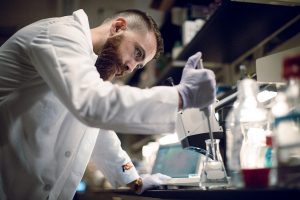Do Plastic Bags Break Down? Is the Threat of Microplastics Overblown? Are We All Just Full of It?
As a researcher in the field of plastic pollution, and as Plastic Oceans International’s Director of Science for North America, I get my fair share of messages telling me how full of it I am about several aspects of the plastic pollution epidemic. Fair point, we can all be wrong sometimes. But I think it’s important to address some of these concerns in a segment that I would like to call … Myth Me With That.

Charlie Rolsky at work in his lab at Arizona State University. Photo: ASU
This time around, I would like to focus on two different but important parts of the plastic pollution epidemic: plastic bags and microplastics.
“Yo Charlie, plastic bags break down in no time duh…”
This is an interesting thought and my first step to investigate this is to look to published literature in order to learn more about this topic. Within a short amount of time, I was able to find an interesting study published by O’Brine and Thompson in 2010, where they conducted experiments to study the degradation of traditional and non-traditional plastic bags under common weathering conditions. This includes important degradative factors, such as UV radiation from the sun, which can aid in breaking down the polymers. They found the bags to persist and be fully intact after 40 weeks of exposure.
Or look to a more recent study, in 2019, by the University of Plymouth, where researchers examined the degradation of five plastic bag materials widely available from high street retailers in the UK. They found that biodegradable plastic bags were still capable of carrying full loads of material after being exposed in the natural environment.
Regardless of their duration in the environment, my concern lies less with the plastic age when fully degraded and more with the idea that plastic bags are actually in the environment for a very long time. Numerous studies have demonstrated their threats to and negative impact on the environment as well as the biota therein. This includes direct links to cetacean mortality, for example.
“Charlie my man, microplastic threats are way overblown! Chill on those.”
The behaviors and threats of microplastics is an increasing, and well-researched department of study. While it can be more difficult to demonstrate their impact relative to macroplastics, we have certainly seen scary implications of their presence in the environment. A few factors are at play here.
1. The chemistry of the plastics themselves should be considered.
Many plastic types contain harmful chemicals, such as phthalates, which have negative implications within the environment. Scientists have studied these contaminants leaching from a variety of commercial products.
2. Microplastics have also been shown to adsorb harmful contaminants
Due to both the plastics and many contaminants being hydrophobic or repelled by water, many harmful pollutants can adsorb to the surface of microplastics at very high concentrations.
3. Microplastics have the ability to penetrate nearly every environment.
Due to their small size, they are able to pass through conventional water treatment, for example, and are then ingested by smaller organisms before moving up the food chain.
Ultimately, plenty of research has demonstrated the negative effects microplastics and macroplastics, such as plastic bags, can have on the environment. Even if we lived in a world where plastic bags degraded in less than a year, for example, that is still ample time for them to threaten marine life and the surrounding environment. It seems as if a week will not go by without a report of cetacean mortality coinciding with plastic bag ingestion. I think we can all agree that an environment free of plastics, macro- or micro-, is more ideal than the opposite.
PLEASE DONATE TO PLASTIC OCEANS
Charles Rolsky is Director of Science, North America, for Plastic Oceans International. He conducts research at Arizona State University’s (ASU) Biodesign Center for Environmental Health Engineering where he works on marine and aquatic plastic pollution, a major concern within many ecosystems and environments around the world.
